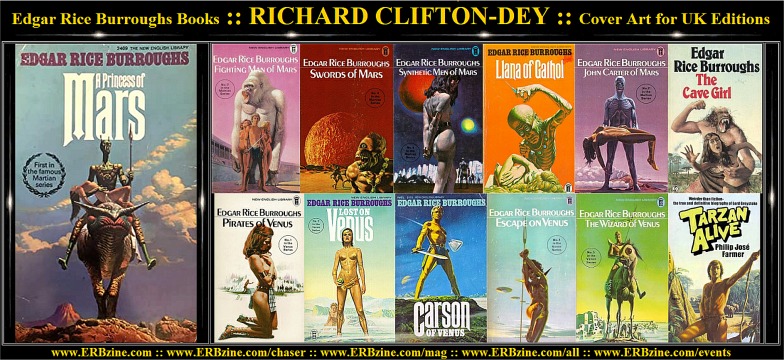
Official Edgar Rice Burroughs Tribute and Weekly Webzine Site Volume 8082 |

Richard
Clifton-Dey was a British paperback cover artist
that I discovered in a book store in Oklahoma City in the 1970s. Among
other
things, “A Points North,” carried British versions of science fiction
and
fantasy books. I remember the proprietor as pompous, but knowledgeable
and
endlessly patient. I was determined to have all of Richard
Clifton-Dey’s Edgar
Rice Burroughs covers. It took three or four years to get them all, but
he’d
order them and send me a postcard when a new one was available. No cell
phones
in those days and I didn’t have an answering machine.
Richard Clifton-Dey was
known mostly for his Western and Science Fiction subjects. Richard almost never
signed his book covers and verification of which
covers were
actually drawn by the artist have been verified by his widow. While his
best
most known work of art may be Behemoth's World, an
illustration for
the rock music album cover Cultösaurus
Erectus by Blue Oyster
Cult, this article will focus on his illustrations for Edgar Rice
Burroughs’
British editions, including the Venus novels, The Cave Girl,
and
all of the Barsoom novels.
He was
very prolific and worked for several publishers and his work was always
in high
demand. The New English Library, Panther,
Mayflower, Sphere, are a few of his customers. His first cover
sale took
place in 1970 at the age of 40, and he didn’t slow down for the next
three
decades, illustrating well over 160
individual book covers. There were 20 unique covers in 1972 alone.
He
illustrated covers for books by Andre Norton, Philip K. Dick, Robert E.
Howard,
Michael Moorcock, Kenneth Bulmer, John Wyndham, Norman Spinrad, and Ray
Bradbury. His work wasn’t limited to
science fiction and fantasy, his covers included romances, war sagas,
westerns,
and even the occasional gothic. His range was beyond legendary, he
illustrated Treasure
of the Sierra Madre, Jane Eyre, and All Creatures Great
and
Small.
Clifton-Dey
started painting in the 1960s and was a well-respected and successful
artist
for over twenty years. Much of his work
was for book covers, science fiction, fantasy, action-adventure war
books,
romances, and gothic horror. Related to
his Edgar Rice Burroughs covers, was his cover artwork for the
novel, Lord
Tyger by Philip
José Farmer in
1974. His realistic artwork graced a British edition of Doc SAVAGE:
His
Apocalyptic Life, also by Philip Jose Farmer.
His Burroughs’
covers frequently featured nudity, that while faithful to ERB’s vision,
would
never have been allowed on a book cover in America. Lost on Venus
is a
perfect example. It’s my personal favorite of his Burroughs’
illustrations. It
featured a frontal view of a beautiful woman clad only in a bikini type
bottom. (Think Ursala Adress emerging
from the ocean in Dr. No, but without a top.) His women, clothed or
unclothed,
and his men are of normal dimensions. No gigantic breasts or
wasp-waisted
heroines. The males, while muscular, aren’t comic book heroes.
His
cover for Fighting Man of Mars
features complete female nudity with some cleverly placed shadows. John
Carrter of Mars, Mastermind of Mars, Synthetic Men of Mars,
Llana of
Gathol, and Escape on Venus have a bare breasted woman of
the
covers. I don’t know how well these sold in Great Britain, but if
they’d have
flown off the shelves in the United States in the 1970s.
The
only criticism I have any of his Burroughs’ covers is that the great
white ape
on Fighting Man of Mars only has two arms and a facial
expression that
looks confused, almost comical, rather than threatening.
Some
sources question crediting the Tandem cover of The Cave Girl to
Richard.
The woman on the cover has a bare breast and the cave man’s mouth looks
eerily
similar to the cyclops’s mouth on Swords of Mars. I’d say it's
certainly
Richard’s work.
Less
titillating, his illustrations almost always included mountains and a
lizard,
large or small, was frequently in plain sight or hidden somewhere.
These
features were almost signatures of Richard’s work. Often a battle or
confrontation of some sort was in the background, rendered in shadows
so as not
to detract from the primary image.
Richard
got the men and women right. Burroughs would give him a
thumbs up, both for accuracy and for his
courage to illustrate them the way he did. He didn’t always get the
other
creatures right, too few arms and legs being a common issue.
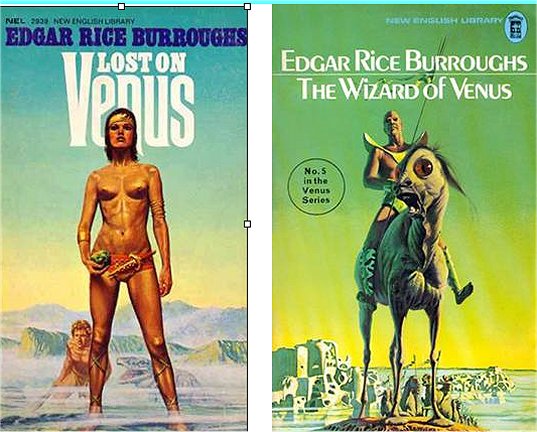
Lost on Venus was the first
Clifton-Dey cover I found. Somehow the image downplays the nudity of
the
female, while emphasizing her strength. Note the trademark lizard and
mountains. As I mentioned earlier, I expect that the artist had watched
the
film, Dr. No, and like most of us, had been captivated by the visual of
Ursala
Andress in a white bikini.
The Wizard of
Venus doesn’t
have a female image, which is unusual for Clifton-Dey, but it is a
nightmarish
iillustration complete with a zombie-like horse, lizards, and moutains
of what
appear to be bones rising from the sea.
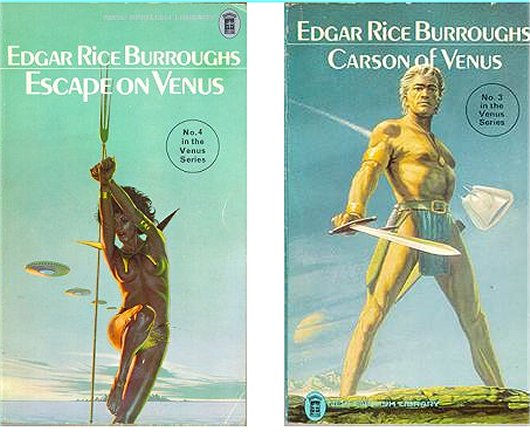
Escape
on Venus features a nude cleverly garbed by lighting and shadow.
No
lizard in sight, but there are distant mountains under the clouds The
visual of
the female hanging from a rope in the sky is a strong. Her strength is
obvious,
but not overstated.
The
design of his Cason of Venus cover
resembles Richard’s cover for Lost on Venus, or maybe it’s the
other way
around. I can’t look at it without thinking of the Colossus of Rhodes.
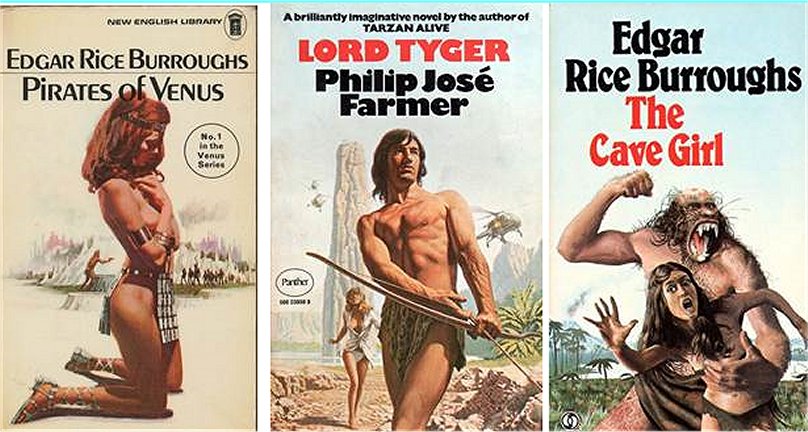
Pirates
of Venus features a semi-nude female kneeling in prayer or
supplication, mountains of course, and even a small lizard back there
somewhere. The detail in her sandals and loincloth are amazing. Richard
frequently includes a small tabloid scene, often a battle in his
backgrounds.
This one is no exception, an armed man, possibly Carson Napier, is
preparing to
confront several men.
His
painting for Philip Jose Farmer’s novel, Lord Tyger cover is
an
interesting combination of the primitive and the advanced, but in all
fairness
so was the novel. I included it in this article for two reasons, the
obvious
ERB reference and the fact that I like the cover. The Tarzan-like
character
wears an animal skin loincloth, but carries a modern-day bow and arrow
– not
much use without a quiver. The scantily clad female, who reminds me of
Raquel
Welch, in the background is fleeing
barefooted over the rocky ground while helicopters pursue the couple.
That arrows
not going to be much use against a helicopter.
The
Cave Girl cover has not always been attributed to Clifton-Dey, but
I
don’t think there’s any question. Mountains in the background and a
small
lizard hidden in the foliage. This cover was once nominated for the
worst
paperback cover ever, but I think that’s a little harsh. The cave man
in the
picture has an expression of confused rage that I’ve only ever seen
once, on a
fellow writer defending his crimes against the English language. A
perfect
example of the phrase, “Anger is the last refuge of the incompetent.”
The
female, unlike the protagonist of Edgar Rice Burroughs’ novel is not
particularly attractive, nor is she well endowed. The expression of
fear on her
face is not the behavior we’d expect from Nadara. She was of made of
sterner
stuff.
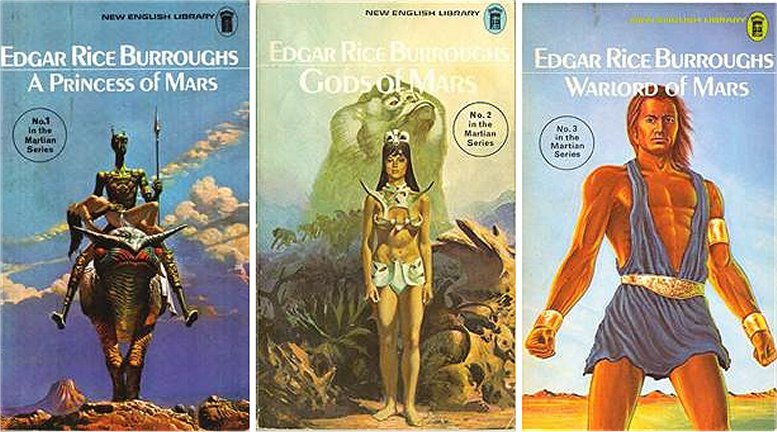
A
Princess of Mars features a bare breasted female being
carried by a two-armed Green Man who is riding a two-legged mount.
Great
artwork, but not accurate. The Green Men of Mars have an intermediate
set of
arms. (That’s taught in Burroughs 101 and the mount of choice, a thoat
has more
than two legs.) Gods of Mars has
a woman clad in what looks like a chastity belt and a spiked collar. A
troop of
monkeys, two-legged and two=armed are in the background. And the third
Barsoomian book cover, Warlord of Mars is of a Bronzed man with
armbands
and a tunic stolen from the set of a Gordon Scott sword and sandal epic
or
maybe it was re-purposed from a Doc Savage cover. I’m not a fan of
these three
covers because of their lack of accuracy to the novels, but they are
beautifully rendered.
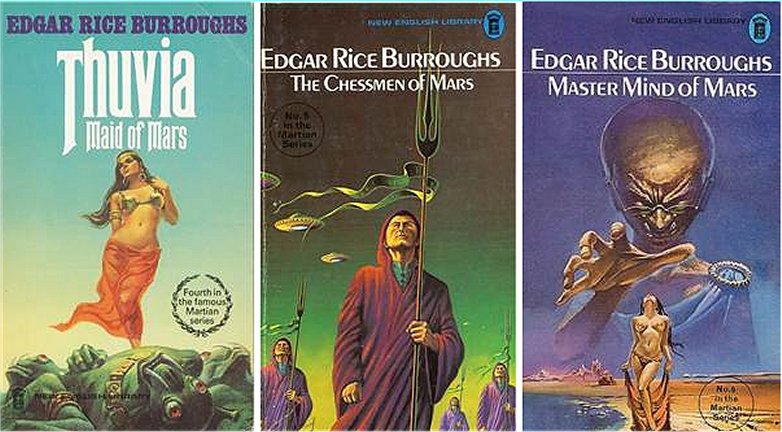
The
next three Barsoom covers by Clifton-Dey are an interesting grouping.
The cover
for Thuvia, Maid of Mars, features a genie-like woman standing
above the
bodies of Green Martian warriors. Made me think of The Birth of
Venus.
The picture is faithful to the novel and the woman is beautiful.
His
cover for The Chessmen of Mars has nothing to do wit the novel.
Flying
saucers and monk-like men with tridents certainly weren’t in the novel.
I
expect this cover was painted for something else and used because of a
publishing deadline. For obvious reasons, I like this the least of any
of his
ERB covers, even less than The Cave Girl. One could make the
argument
that the men are the “grotesque statuettes of men” lining the entrance
to the
city of Manator, but I don’t agree. The dress in purple robes isn’t
consistent
with Barsoomian clothing and for the life of me, I don’t recall any use
of
tridents as a Martain weapon. With Jetan scenes, Tara of Helium, and
Kaldanes
and Rykors to choose from, I don’t believe that Richard would have
chosen this
as an illustration for The Chessmen of Mars. It belongs on
something
like A Canticle for Lebowitz.
Richard’s
cover for Mastermind of Mars is a classic. An ominous image of
the
scientist, Ras Thavas, in the sky reaching for an almost naked female
standing
on the edge of a lake. A lake on Barsoom? Predominately a painting in
blue and
tan, it manages to evoke the woman’s helplessness and the evil
scientist’s
glee-like satisfaction with his power.
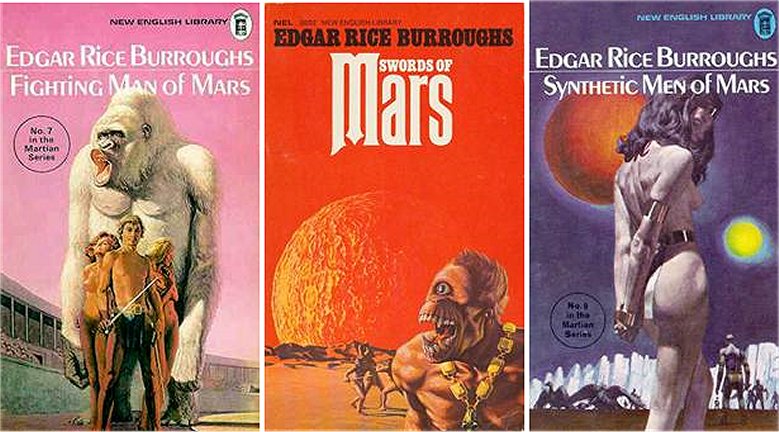
Covers
seven, eight, and nine are beautifully rendered, as is always the case
with
Clifton-Dey’s work. Fighting Man of Mars features total female
nudity
with artfully placed shadows. The Great White Ape is missing a set of
arms had
has that vacuous expression which previously appeared on Richard’s The
Cave
Girl cover. I’d swear that I know that face.
Swords
of Mars, a study in orange and shadows is incredibly detailed.
Taking place on a Barsoomian moon, the red planet fills the sky. I
questioned
the cyclops at first, but it’s an accurate rendition of inhabitants of
Thuria,
one of the moons of Barsoom.
Synthetic
Men of Mars, a study in purple is amazing. A
bound bare-breasted woman hangs her head in the foreground. The muscles
on her
back are detailed and show the tension of having her arms restrained.
Her head
is turned toward the viewer and she makes eye contact, perhaps in fear
or
perhaps in a silent plea for a help. A man with a sword is preparing to
defend
her against a squadron of opponents moving toward her. Two malagors
strive to
take flight at the base of a cliff. The two moons of Barsoom, one
orange and
one yellow fill the sky. I love this one.
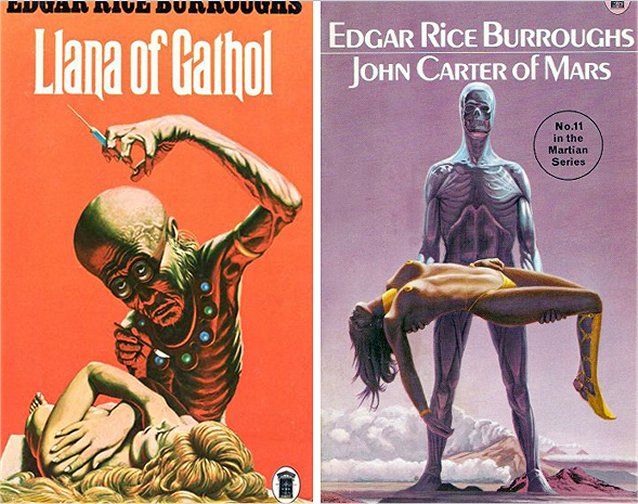
Llana of Gathol and John
Carter of
Mars both feature female nudity. Again, Clifton-Dey revisits the
orange and
purple cover themes. For Llana of Gathol, he has a female,
presumably
Llana, threatened by Ras Thavas, a villain making his second cover
appearance.
Richard has illustrated Thavas as bone thin, he liked to draw ribs
apparently.
John
Carter of Mars uses two colors, not counting black
and white, purple and yellow. The zombie-like humanoid in the
foreground
painfully presents an unconscious female to persons or a fate unknown.
Powerful
images, both of them.
Richard
Clifton-Dey didn’t always illustrate his Burroughs covers true to the
stories,
but with the exception of the garish The Cave Girl cover, he
always drew
beautiful illustrations using shadows and color to evoke the desired
response.
Menace and power, he drew both masterfully.
Full Information for the ERB Titles
Featured Here
at our ERBzine Bibliography Pages
https://www.erbzine.com/craft/
BILL HILLMAN
Visit our thousands of other sites at:
BILL and SUE-ON HILLMAN ECLECTIC STUDIO
ERB Text, ERB Images and Tarzan® John Carter® Priness of Mars® are ©Edgar Rice Burroughs, Inc.- All Rights Reserved.
All Original Work ©1996-2025 by Bill Hillman and/or Contributing Authors/Owners
No part of this web site may be reproduced without permission from the respective owners
